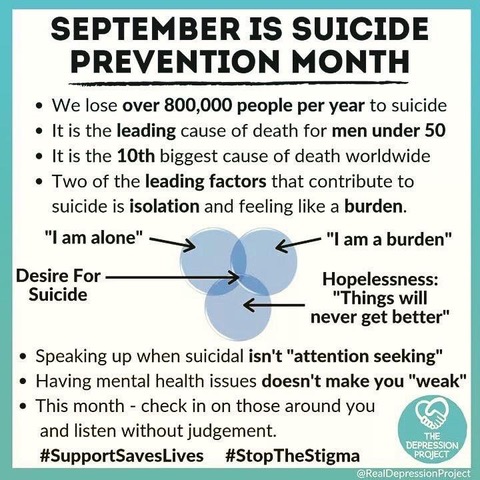How to Stop Comparing Yourself to Others
How to Stop Comparing Yourself to Others – A Helpful Guide Read More
Suicide Prevention
September is Suicide Prevention Month- #SupportSavesLives #StopTheStigma

Parenting
Wholehearted Parenting Manifesto– by Brene Brown Above all else, I want you to know that you are loved and lovable. You will learn this from my words and actions – the lessons on love are in how I treat you and Read More
Meditate
Jen Weston is retired following more than 20 years as executive director of a nonprofit organization. She is a certified yoga instructor and teaches 2-3 times a week and has a few web based side gigs.
Don’t be scared of the “M” word!!
“Learn to meditate – it will eliminate your stress, help you sleep better, make you feel happier, revolutionize your life!” You’ve probably heard it or read it before “You should learn to meditate.” Those words can immediately make us think of discomfort and difficulty. It is equally difficult to believe meditation will solve all of the problems it is credited with. You may envision someone sitting cross-legged for hours on a hard floor chanting a word or sound. It can make your back hurt just to think about it. And besides, who has the time to learn to meditate – not only can it sound uncomfortable but it sounds like it’s difficult to learn. “That’s the last thing I need” I hear you say!!
Don’t be scared – there are actually many, many ways to meditate – it’s a case of finding what works for you. And while meditation may solve numerous problems for many people, the most important thing it can do for almost everyone is calm the mind . . . which in turn can help put you on a course for solving all sorts of things. It’s the stillness that’s the key – not the posture or location or words. Stilling the mind, stilling the body. Good things will follow.
“Classic meditation” (sitting cross-legged, eyes closed, chanting a mantra word, etc) does indeed work for many, many people. But it’s not what works for everyone. I’m one of those people. And I’ve tried hard – I teach yoga so I’ve had many opportunities to try the classic style. Just doesn’t work for me.
Take away the often intimidating word “meditation” and think stillness and it’s easier to understand. Still the mind, still the body – often at the same time. The rewards can be enormous. Yoga is often considered a moving meditation – still the mind while the body works. After many yoga classes one lies still – both mind and body still, the reward for hard work.
Stillness is something not found often in our lives. Constant distraction from work, our devices, and interruptions of all sorts leave little time for our minds to be still. Yet stillness creates relaxation in both our bodies and minds and can leave us feeling refreshed, relaxed, more at peace and more ready to face the demands of life.
Try this. Sit quietly – find a comfortable position that works for you, a chair, a sofa, the floor, whatever. Slow your breathing – in for 4 -5 counts, out for 4 -5 counts. Still your mind. Don’t fight your thoughts but don’t focus on them, don’t try to problem solve, don’t work on the “to do” list. Try to focus on the sound and feeling of your breath moving in and moving out. If you like, close your eyes. Or just let your gaze rest comfortably on something still, or close to still . . . a tree, cloud, an object nearby. Don’t analyze the object just let your eyes stay there, keep them still. Your slow, consistent breathing will calm your body and your mind. Stay focused on your breath. It’s not easy. But stick with it. Like anything new it takes practice.
Maybe try for a few minutes the first go around. If something doesn’t feel right change it the next time – where you were sitting, your position, where your gaze rested. Tomorrow make adjustments and try again. Once you find what seems comfortable for you stick with it, a few minutes every day. It will take some commitment. To make it a habit you’ll need to do it every day, and may need reminders (our devices are helpful for this!!). Start with a couple of minutes every day, or even a couple of times a day. You may have a place at home and one at work that you can use. Set aside a few minutes every day for two weeks and practice your stillness.
Make this time for yourself. You deserve it, you need it, your brain needs it, your body needs it. Stillness. At the end of two weeks add a minute or two to the time you set aside for your stillness, your meditation. Continue for another two weeks. Hang in there. You may miss a day – don’t worry about it. Keep at it and you’ll turn it into a habit. Your brain and your body will start to remind you to take this time for yourself. Add more time, maybe work up to 10 minutes, 15, 20. Find the amount of time that works best for you. It doesn’t have to be complicated. It may seem difficult – that’s ok. Hang in there.
You can do this. Stillness, breath, stillness, breath. You’ll start to see a difference somewhere in your life and in your body.